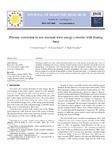Primary conversion in non-resonant wave energy converter with floating buoy
Title
Primary conversion in non-resonant wave energy converter with floating buoyDate
2019Citation
Borrás Formoso, R.G., Ferreiro García, R., & Antelo González, F. (2019). Primary conversion in Non-Resonant Wave Energy Converter With Floating Buoy. Journal of Maritime Research: JMR, 16(2), 3-9. https://www.jmr.unican.es/index.php/jmr/article/view/490/610
Abstract
[Abstract] This paper studies one of the technical problems that occur in the process of moving from ”waves toelectricity” in floating wave buoys converters located near the coast: to maximize the product force bydisplacement. It is proposed a first converter stage only with mechanical elements of low inertia andabsence of fluids, showing the advantage of using a accumulator with spring to achieve high accelera-tions by means of a converter design suitable to mount the mentioned stage. A comparative analysis ismade with the most suitable tension for the springs according to the height of the waves provided at thelocation of the converter.
Keywords
Wave energy converter (WEC)
Wave energy
Renewable energies
Energy storage
Moment of inertia decoupling
Wave energy
Renewable energies
Energy storage
Moment of inertia decoupling
Editor version
Rights
©SEECMAR |All rights reserved
ISSN
1697-404
Related items
Showing items related by title, author, creator and subject.
-
Estudo enerxético e proposta de mellora dun edificio residencial situado en Touro (A Coruña)
Ares Igrexas, Iván (2021)[Resumo] O presente traballo ten a finalidade a de ser o proxecto de fin de grao da titulación do Grao en Arquitectura Técnica na Universidade da Coruña. A realización do mesmo foi supervisada polos profesores Juan Luís ... -
Methodology to Calculate the Costs of a Floating Offshore Renewable Energy Farm
Castro-Santos, Laura; Martins, Elson; Guedes Soares, Carlos (Multidisciplinary Digital Publishing Institute, 2016)This paper establishes a general methodology to calculate the life-cycle cost of floating offshore renewable energy devices, applying it to wave energy and wind energy devices. It is accounts for the contributions of the ... -
An approach to Energy Planning in Germany - Energy Transition towards a low-carbon economy: Analysis and application of Modern Portfolio Theory to the German Electricity Mix
Afonso Arévalo, Javier Eduardo (2020)[Abstract]: The targets of this Final Degree Thesis are to explain the current situation of the German Energy Sector, its evolution over time, to compare its features with the European Union Energy Sector, and finally, to ...






